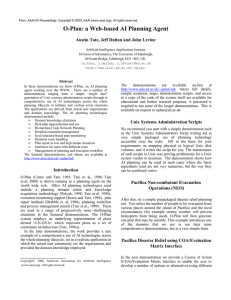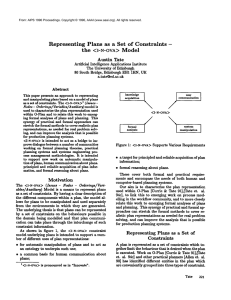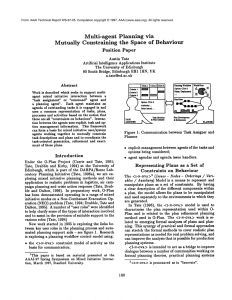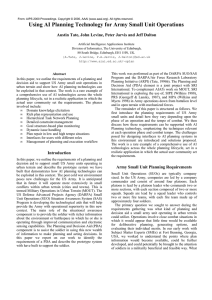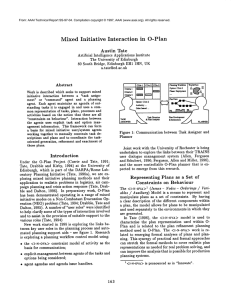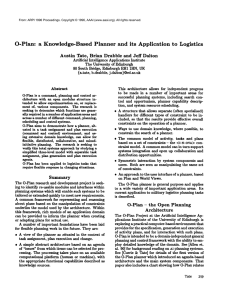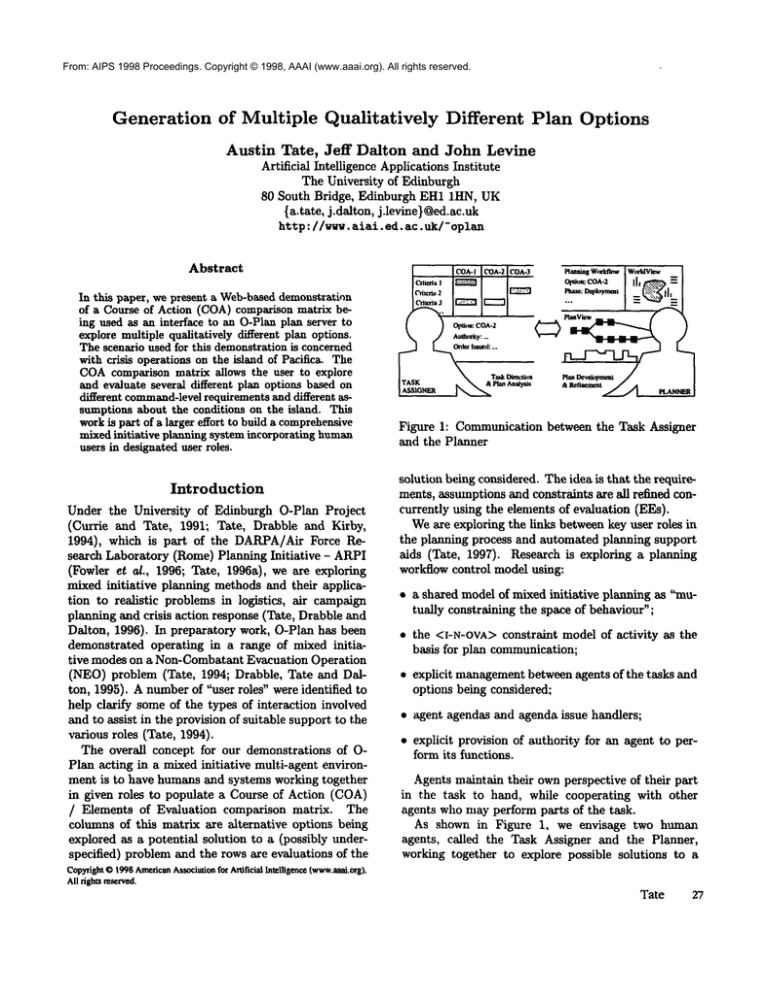
From: AIPS 1998 Proceedings. Copyright © 1998, AAAI (www.aaai.org). All rights reserved.
Generation of Multiple Qualitatively
Austin ’rate,
Jeff
Different Plan Options
Dalton and John Levine
Artificial Intelligence Applications Institute
The University of Edinburgh
80 South Bridge, Edinburgh EH1 1HN, UK
{a.tate, j.dalton, j.levine}@ed.ac.uk
http://vvv.
aiai.ed.ac.uk/-oplan
Abstract
COA-ICOA-2COAo3
In this paper, we present a Web-baseddemonstration
of a Course of Action (COA)comparison matrix being used as an interface to an O-Plan plan server to
explore multiple qualitatively different plan options.
The scenario used for this demonstrationis concerned
with crisis operations on the island of Pacifica. The
COAcomparison matrix allows the user to explore
and evaluate several different plan options based on
different command-level
requirementsand different assumptions about the conditions on the island. This
workis part of a larger effort to build a comprehensive
mixedinitiative planning system incorporating human
users in designateduser roles.
Introduction
Under the University of Edinburgh O-Plan Project
(Cuttle and Tate, 1991~ Tate, Drabble and Kirby,
1994), which is part of the DARPA/Air Force Research Laboratory (Rome) Planning Initiative - ARPI
(Fowler et al., 1996; Tate, 1996a), we are exploring
mixed initiative planning methods and their application to realistic problems in logistics, air campaign
planning and crisis action response (Tate, Drabble and
Dalton, 1996). In preparatory work, O-Plan has been
demonstrated operating in a range of mixed initiative modes on a Non-Combatant Evacuation Operation
(NEO) problem (Tare, 1994; Drabble, Tate and Dalton, 1995). A numberof "user roles" were identified to
help clarify some of the types of interaction involved
and to assist in the provision of suitable support to the
various roles (Tare, 1994).
The overall concept for our demonstrations of OPlan acting in a mixed initiative multi-agent environment is to have humans and systems working together
in given roles to populate a Course of Action (COA)
/ Elements of Evaluation comparison matrix. The
columns of this matrix are alternative options being
explored as a potential solution to a (possibly underspecified) problem and the rows are evaluations of the
CopyTight© 1998 Amefic~Association fc~ Artificial
All rights reserved.
Intelligeur~
o~,.:co^-2
i il,~ = i
t’vh©fi,~
2
(."rilim"ial
,)
Onlcr
luued:
...
Figure 1: Communication between the Task Assigner
and the Planner
solution being considered. The idea is that the requirements, assumptions and constraints are all refined concurrently using the elements of evaluation (EEs).
Weare exploring the links between key user roles in
the planning process and automated planning support
aids (Tate, 1997). Research is exploring a planning
workflow control model using:
¯ a shared model of mixed initiative planning as "mutually constraining the space of behaviour";
¯ the <I-N-OVA>constraint model of activity
basis for plan communication;
as the
¯ explicit managementbetween agents of the tasks and
options being considered;
¯ agent agendas and agenda issue handlers;
¯ explicit provision of authority for an agent to perform its functions.
Agents maintain their own perspective of their part
in the task to hand, while cooperating with other
agents who may perform parts of the task.
As shown in Figure 1, we envisage two human
agents, called the Task Assigner and the Planner,
working together to explore possible solutions to a
(www.um.ccg).
Tate
27
From: AIPS 1998 Proceedings. Copyright © 1998, AAAI (www.aaai.org). All rights reserved.
COAlC;OAZ. COAZ
Figure3: Generic
Systems
Integration
Architecture
Refine
Plans
T~k "~ $ eled: Eva lu~.tions
Assigr~r
K
Planner
Figure 2: Roles of the Task Assigner and the Planner
problem and making use of automated planning aids
to do this. Figure 2 shows how the two human agents
work together to populate the COAcomparison matrix. The Task Assigner sets the requirements for a
particular Course of Action (i.e. what top level tasks
must, be performed) and selects appropriate e~aluation
criteria (elements of evaluation) for the resulting plans.
The Planner agent acts to refine the resulting plans by
adding further constraints and splitting plans to explore two or more possible options for the same COA
requirements.
In this paper, we describe our current Web-based
demonstration of a Task Assigner interacting with OPlan via a COAcomparison matrix, together with the
ba~’kground to this demonstration. Westart with the
generic systems architecture being used and the architecture of the O-Plan system being used as a plan
server. Wethen describe mixed initiative
planning
where multiple agents mutually constrain the space of
behaviour. The current Web-based demonstration of
our ideas is then presented, followed by a summaryand
future directions.
support
usertasksviaappropriate
useof theprocessing
andinformation
assets
andto assist
theuser
in managing
optionsbeingusedwithinthe model.
Thisis sometimes
referred
toas theController.
ModelManagement:
coordination
of the capabilities/assets
torepresent,
store,
retrieve,
merge,
translate,compare,
correct,
analyse,
synthesise
andmodi~"models.
Mediators:
Intermediaries
or converters
betweenthe
features
of themodelandtheinterfaces
of active
components
of thearchitecture.
Processing
Assets:functionalcomponents(model
analysis,
synthesis
ormodification).
ConstraintManagers:componentswhichassistin
themaintenance
of theconsistency
of themodel.
Information
Assets:information
storageand retrieval
components.
O-Plan - the Open Planning
Architecture
Thissection
describes
theO-Plan
architecture
andthe
structure
of individual
O-Planagents.The componentsof a single
O-Planagentareshownin Figure
4.
R~luimnmnts
¯
Generic
Systems
Integration
Architecture
The O-Plan agent architecture to be described in the
next section is a specific variant of a generalised systems integration architecture shown in Figure 3. This
general structure has been adopted on a number of
AIAI projects (Fraser ,and Tate, 1995). The architecture is an example of a Model/Viewer/Controller arraalgement. The components are as follows:
Viewers: user interface, visualisation
tion viewers for the model.
and presenta-
Task and Option Management: the capability
28
Applications
to
-- 11
P~.nlentsl.
i
.I ~’’~fIIHi
,.,.... ,,F .
J
~ F’lanStatc
II
C¢l~i~li[~l"
i~i"l
~1|
I
r
I1~’I’)1
I
,
,
,
Figure 4: O-Plan Agent Architecture
Task and Option Management
Taskand optionmanagement
facilities
are provided
by the Controller
in O-Plan.The O-PlanController
takesitstasksfroman agenda
whichindicates
theoutstanding
processing
required
andhandles
thesewithits
Knowledge Sources.
From:
AIPS 1998
Proceedings.
Copyright ©for
1998,
AAAI (www.aaai.org).
rights reserved.
O-Plan
hasexplicit
facilities
managing
a num- AllRepresenting
berof different
options
whichit is considering.
O-Plan
hasan agentlevelagenda,
andagendas
whichrelate
to
eachoption
it isconsidering
(infactthesearepartof
theplanrepresentation
fortheseoptions
- theissues
or I partof <I-N-OVA>).
Manyof theseoptions
areinternalto theplanning
agent,andaregenerated
during
thesearch
fora solution.
Others
areimportant
forthe
interaction
between
theplanner
anda useractingas a
taskassigner.
Abstract
Model of Planning
Plan Modification
Operators
Workflow
-
A general approach to designing AI-based planning
and scheduling systems based on partial plan or partial
schedule representations is to have an architecture in
which a plan or schedule is critiqued to produce a list
of issues or agenda entries which is then used to drive
a workflow-style processing cycle of choosing a "plan
modification operator" (PMO)to handle one or more
agenda issues and then executing the PMOto modify
the plan state. Figure 5 showsthis graphically.
Plan State
Implied
Constraints
Plan Level
Constraints
Detailed
Constraints
I Plan Agenda 1
I
as a Set of Constraints
- Nodes - Orderings / Variables / Auxiliary) Model is a means to represent and
manipulate plans as a set of constraints.
In Tate (1996b), the <l-N-OVA> model is used to
characterise the plan representation used within OPlan and is related to the plan refinement planning
method used in O-Plan. A plan is represented as a set
of constraints which together limit the behaviour that
is desired when the plan is executed. The set of constraints are of three principal types with a number of
sub-types reflecting practical experience in a number
of planning systems.
The <I-N-OVA> (Issues
Plan Constraints
I - Issues (Implied Constraints)
N - Node Constraints(on Activities)
OVA - DetailedConstraints
0 - OrderingConstraints
V - VariableConstraints
A - AuxiliaryConstraints
- AuthorityConstraints
- ConditionConstraints
- ResourceConstraints
, Choose(PMO)
- SpatialConstraints
- MiscellaneousConstraints
Figure 6: <I-N-OVA>Constraint Model of Activity
Do(PMO)
I
Plan Constraints]
Plans
on Behaviour
Propagate
Constraints
x’~
//-Space of Legitimate
Plan Elaborations
Figure5: Planning
Workflow- UsingPMOsto Handle
AgendaIssues
This approach is taken in O-Plan. The approach fits
well with the concept of treating plans as a set of constraints which can be refined as plmmingprogresses.
Somesuch systems can act in a non-monotonic fashion
by relaxing constraints in certain ways. Having the
implied constraints or "agenda" as a formal part of
the plan provides an ability to separate the plan that
is being generated or manipulated from the planning
systemitself.
The node constraints (these are often of the form
"include activity") in the <I-N-OVA>
model create the
space within which a plan may be further constrained.
The I (issues) and OVAconstraints restrict the plans
within that space to those which are valid. Ordering
(temporal) and variable constraints are distinguished
from all other auxiliary constraints since these act as
cross-construints, usually being involved in describing
the others - such as in a resource constraint which will
often refer to plan objects/variables and to time points
or ranges.
The <I-N-OVA>constraint model of activity allows
planning process state as well as the current state of the
plan generated to be communicatedbetween agents involved in the planning process. This is done via the Issues part of <I-N-OVA>- which can be used to amend
the task and option specific agenda which a planning
agent is using for its problem solving.
Authority
to
Plan
As described in Tate (1993) it is intended that O-Plan
will support authority management in a comprehensive and principled way. Changesof mlthority are posTalc
29
sible
Task
Assignment
agent© communication
to the All rights
domain
which is
From:
AIPSvia
1998
Proceedings.
Copyright
1998, AAAI (www.aaai.org).
reserved.
Planner agent. This may be ill the context of a current. plan option and task provided previously or it is
possible to give defaults which apply to all future processing by the planner agent. The authorities may use
domain related names that are meaningful to the user
and may refer to the options, sub-options, phases and
levels of tasks and plans knownto O-Plan.
an extension of our earlier logisticsrelated domains (Reece e$ al., 1993).
This demonstration is a significant milestone on the
path towards our stated vision, since it contains many
of the elements which have been planned for over the
last 3 to 4 years of work and which have been incorporated into O-Plan Version 3.1 since its release in January 1997. These include:
Mutually Constraining Plans for Mixed
Initiative
Planning and Control
¯ Multiple option management: exploration
rate options mid sub-options.
Our approach to Mixed Initiative Planning in O-Plan
assists in the coordination of planning with user interaction by employinga shared model of the plan as a set
of constraints at various levels that can be jointly and
explicitly discussed between and manipulated by any
user or system component in a cooperative fashion.
The model of Mixed Initiative Planning that can be
supported by the approach is the mutual constraining of behaviourby refining a set of "alternative partial
plans. Users and systems can work in harmony though
employing a commonview of their roles as being to
constrain the space of admitted behaviour. Further
detail is given in Tate (1994).
Workflowordering mid priorities can be applied to
impose specific styles of authority to plan within the
system. One extreme of user driven plan expansion
followed by system "filling-in" of details, or the opposite extreme of fully automatic system driven planning
(with perhaps occasional appeals to an user to take
predefined decisions) are possible. In contrast with
this, our goal is to establish a mixed initiative form
of interaction in which users and system components
proceed by mutually constraining the plan using their
ownareas of strength.
Coordination of problem solving must take place between users and the automated components of a planning system. In joint research with the University of
Rochester (whose work is described in Allen, Ferguson
mid Schubert, 1996) we are exploring ways in which the
O-Plan controller can be given specific limitations on
what plan modifications it can perform, and the specific plan options or sub-options it is working on can
be coordinated with those being explored by a user
supported by a suitable interface.
¯ Multiple initial conditions: exploration of different
initial assumptions about the domain.
A Web-based
Demonstration
This section describes our current implementation of
these ideas. Wehave constructed a Web-based demonstration of a task assignment agent working with the
O-Plan planning agent to populate and explore different options within a course-of-action matrix. Weare
using a general-purpose logistics and crisis operatioils
30
Applications
of sepa-
¯ Incremental tasking: adding further requirement
constraints to a plan after an initial phase of planning.
¯ Authority to plan: authorities can be set for any
COAinvestigated allowing for incremental plan refinement alongside user directed ’addition of planning
constraints.
¯ Plan analysis: facilities tbr plan analysis/evaluation
can be installed which have both brief and longer
amdysis results to present to the user.
¯ Evaluation selection: the evaluations presented can
be selectcd to show the ones which are critical.
¯ Issue nlaintenance: planning or plan analysis can
leave outstanding issues to be addressed, which are
summarised and collected to help with planning and
coordination workflow.
¯ Status indication: coloured "traffic lights" are used,
as in other ARPIplan visualisation work (Stillman
mid Bonissone, 1996) to indicate that a chosen plan
for a COAis complete (green), has warnings or notes
to read (orange) or have issues that need attention
(red).
The Webdemonstration, Version 3.1 of the O-Plan
code and the papers referenced here axe available by
following links from the O-Plan homepage.
The COA Comparison
Matrix
The user is initially
given a blank COAcomparison
matrix which is populated by the user and O-Plan during the course of a session (Figure 7). The user acts
in the role of the Task Assigner agent, setting the initial assumptions and tasking level requirements for a
Course of Action (Figure 8) and selecting elements
evaluation to include in the matrix. The task assigner
can split any COAinto two or more sub-options and
explore further within each. Additional constraints (in
From: AIPS 1998 Proceedings. Copyright © 1998, AAAI (www.aaai.org). All rights reserved.
Figure 7: The Course of Action Evaluation Matrix
the form of task level requirements) can be added to
any COA.The task assigner can also authorise O-Plan
only to plan to a nominated level of detail. Together,
these facilities "allow for incremental development, exploration and evaluation of multiple qualitatively different plan options.
The COAmatrix is an abstract underlying notion
and may not appear in a user interface for a completed
system. However, it is useful in this demonstration to
show our ideas about what is being created and refined
as mixedinitiative problemsolving takes place. In a dialngue system, such as TRAINS(Ferguson, Allen and
Miller, 1996), the COAmatrix would be the underlying model of the problem solving and the dialogue
model wouldthen implicitly refer to this artefact.
"Go Places
and Do Things"
- The Crisis
Operations
Domain
Wehave used a crisis operations domain based on the
Pacifica scenarios (Reece et al., 1993; Tate, Drabble
and Dalton, 1996) that we call "Go Places and Do
Things" (GPDT). This is a three level domain model
which closely follows what we observe in large real domain models. The top level is mostly about setting
objectives (i.e. COArequirements). The second level
is the real planning level and where technological interactions, such as allocating limited resources, need
to be resolved. The third level is needed to add detail
to the skeleton plans that have been selected.
Figure 8: Defining the Requirements for a Course of
Action
This domain is a natural extension of our earlier
work in the Pacifica Non-combative Evacuation Operations (NEO) domain. In the earlier work, people
are evacuated (following some crisis) from a small isla~d using trucks and helicopters. In the new domain,
the main goal is to avert a developing crisis in one of
the cities on the island, using various vehicles, pieces of
equipment and specialist teams. In the crisis domain,
unlike previous Pacifica scenarios, the tasks to be performed are complex and may involve plans consisting
of hundreds of individual actions.
This domain has been chosen for our current work to
demonstrate that O-Plan is sufficiently powerful to be
able to cope with these complicated logistical problems
and also to provide the O-Plan team with a problem
domain which is general enough to allow expansion and
experimentation as our ideas and technology develop.
The Scenario The action takes place somewhere in
a networkof cities, currently on the island of Pacifica
(see Figure 9). A numberof crisis situations can arise
in the cities and on the roads joining them, such as
power stations becoming inoperative or people needing
medical treatment. The goal of the commander(i.e.
the Task Assigner agent) is to respond effectively to
the situation so that the immediate crisis situation is
dealt with and appropriate repairs are made to restore
the status quo.
Tate
31
People:
people
From: AIPS 1998 Proceedings. Copyright © 1998, AAAI (www.aaai.org). All rights
reserved.
are located at cities and may need
medical treatment or evacuation. As a simplification, we treat people as a single entity to be treated
or nmved around, rather than counting a specific
number.
Weather: the weather may restrict the options available to the planner, such as not allowing helicopters
to fly in thunderstorms.
The world state can be described by giving the locations and contents of the vehicles, the locations of the
people, teanls and pieces of equipment, and the status
of the roads, people and weather.
Actions and Plans In this domain, the teams,
equipment and people can be moved around using a
TRANSPORT
action at modelling Level 2:
TRANSPORTcargo ITEM using VEHICLEfrom
CITY to CITY
where ITEMis an object of type team, vehicle,
equipment or people.
Figure 9: The Island of Pacifica
World Description The following
exist in this domain:
types of objects
Cities: these can contain other objects, such as teams,
people and equipment.
The result of the action is that the cargo movesfrom
the source to the destination.
Other actions in the domain are dependent on the
specific exaxnple chosen, but will typically contain
around 5 actions at. a lower level of detail. Typical
examples are:
¯ Repair a turbine at a crucial powerstation.
¯ Give emergency medical treatment
posed to toxic fumes.
to people ex-
Roads: these connect some of the cities. They may
becomeblocked to certain classes of vehicle due to
weather conditions or landslides. Somemay be permanently blocked to certain classes of vehicle (e.g.
mud tracks).
¯ Repair a bridge which has been broken in a storm.
Vehicles: these are used to carry equipment, teams
and people between cities. There are various types
of vehicle whichhave very different capabilities, such
as fast air vehicles of low carrying capacity and slow"
ground transports capable of carrying large pieces of
equipment.
¯ Evacuate the population of one of the cities.
Equipment: there are various pieces of specialist
equipment located in the network of cities. These
are needed to perform certain tasks, such as repairs
at a power station or emergency medical treatment.
Implementation Status The current O-Plan Task
Formalism (TF) file for this domain implements the
crisis operations domainfor the island of Pacifica, using 12 top level tasks and four cities (Abyss, Barnacle,
Calypso and Delta). A Course of Action consisting of
5 tasks at the top level expands to give approximately
30 actions at, the secondlevel and 150 tasks at the third
level. The exact numbers will depend on the particular
Level 1 tasks selected for the Course of Action.
Teams: there are also various specialist teams of people located in the cities. These teanls perform specialist tasks, such as fast evacuation or building
emergency housing.
32
Applications
¯ Build emergency housing for refugees.
¯ Perform emergency operations to make the area safe
for a repair team.
An entire plan will consist of a number of TRANSPORToperations to bring the necessary teams and
equipment together, followed by the main tasks. The
TRANSPORT
operations and main tasks may overlap,
as in our denmnstration example which follows.
From:
1998 Proceedings. Copyright
rightsdefuse
reserved.
The AIPS
Demonstration
Scenario© 1998, AAAI (www.aaai.org). Alland
the
The following scenario illustrates how we envisage the
system being used and can be used in actual demonstrations of this work.
The task assigner (TA) is told that thcre are injured
people in Abyss, Barnacle and Calypso and that these
people need to be treated within the next 18 hours in
order to avoid fatalities.
The latest weather forecast
shows a 50% chance of a storm over Pacifica during
the next 24 hours.
The TA decides to try evacuating the injured from
all three cities as the first possible plan, using the assumption that the weather is clear. The evaluation
criteria are fine and the plan executes within the required deadline. This illustrates
how the TA sets up
tasks and assumptions within COAsand how the interface displays the elements of evaluation in the matrix.
The TAwants to check that the plan is still OKif
the predicted storm occurs. A further COAis added
with the tasks being set up as before. This time, the
TA sets the weather to "storm". O-Plan is asked to
generate a plan for this new set of COArequirements
and finds that the time taken to execute is 18 hours
- just on the deadline. This illustrates the basic use
of COAcolumns to compare different courses of action
based on different initial assumptions.
However, the TA is now interrupted by a call from
the Barnacle field station. Reports are comingin of an
explosion at the main Barnacle power station, causing
a gas leak. It is thought that this mayhave been caused
by a terrorist bomb. It seems wise to fix the gas leak
and send a bomb squad to deal with any other bombs
that may have been planted. Meanwhile, the latest
weather bulletin indicates that a storm is brewing to
the north-east and has a 95% chance of hitting the
island within the next 5 hours.
To deal with these turns of events, the TA now
splits COA-2(the realistic weather assumption) into
two sub-options and adds two new tasks to one of them
- COA-2.2. The new tasks are to repair the gas leak
at Barnacle and to defuse other (potential) terrorist
bombs at Barnacle. This illustrates
the use of plan
splitting and addition of new tasks. Unfortunately for
the TA, the new plan takes 24 hours: which is 6 hours
over the deadline.
The TA now needs to think. The stormy weather
prediction has become more definite, so the TA sets
the default weather assumption to be "storm". Then
a further COAcolumn is added (COA-3). Since the
original task was to simply to treat the injured people
at the three cities, evacuation is perhaps all unnecessary luxury. The TA therefore sets up COA-3to send
medical teams to the three cities, repair the gas leak
terrorist bombat Barnacle. Since the
default for the weather is "storm", the TA does not
need to note this explicitly. The resulting plan completes within 14 hours, so this new plan seems like the
best one so far. The "traffic light" indicators in the
matrix show various warnings, mostly concerned with
using all available resources of a certain type within the
plan. The TAmarks all of these as being acceptable
and the traffic lights in the column for COA-3turn
green, indicating that the plan is ready to execute.
As a final optiinisation, the TAadds another column
(COA-4) and sets this up as for COA-3,but with the
injured being evacuated from Barnacle rather than a
medical team sent (because of the additional danger in
Barnacle due to the gas leak and/or terrorist bombs).
This plan executes within 17 hours, which is 1 hour
less than the deadline.
Future
Work
Thecurrent
demonstration
stillhassomelimitations,
and we planto addressthesein our finalproject
demonstration
(duein June1998).The mostimportantitemto be addressed
is to addthehumanplanner
agentintothedemonstration,
withthetaskassigner,
plannerandO-Planagentallactingtogether
to exploretheplanspacein a truemixedinitiative
interaction.Thiswillrequire
thatnewfacilities
be addedto
supportthe humanplanneragentand thatcommunicationbetween
agentsbe provided
viaWebinteraction
and teleconferencing.
We envisage
thatthe planner
agentandthetaskassigner
willhavedifferent
interface
viewsontotheCOAmatrix,
as illustrated
in Figure1.
We alsointendto improve
thetreatment
of thecrisis
operations
domain
andallowplansto be specified,
visualised
andrefined
viaa graphical
Java-based
process
editorandplanviewer.
Summary
Five concepts are being used as the basis for exploring multi-agent and mixed-initiative planning involving users and systems: Together these provide for a
shared model of what each agent can and is anthorised
to do and what those agents can act upon.
1. Shared Plan Model - a rich plan representation using a commonconstraint model of activity (<I-NOVA>).
2. Shared Task Model- Mixed initiative model of "mutually constraining the space of behaviour".
3. Shared Space of Options - explicit
ment.
option manage-
Tate
33
4. Shared
Model
of Agent
Processing
handlers
for All rights
Fowler,
N.,
From:
AIPS 1998
Proceedings.
Copyright
© 1998,-AAAI
(www.aaai.org).
reserved.
issues, functional capabilities
agers.
aald constraint man-
5. Shared Understanding of Authority . managementof
the authority to plan (to handle issues) and which
may take into account options, phases and levels.
Using these shared views of the roles and function
of various users and systems involved in ~. command,
planning and control environment, we have demonstrated a planning agent being used to support mixed
initiative task specification and plan refinement over
the world wide web. It ha.s been applied to the generation of multiple qualitatively different courses of action
based on emerging requirements and assumptions. The
demonstration takes place in a realistic crisis manage:uent domain.
Acknowledgements
The O-Plan project is sponsored by the Defense Advanced Re.search Projects Agency (DARPA)and the
US Air Force Research Laboratory at Rome(AFRL),
Air Force Materiel Commaald, USAF, under grant
number F30602-95-1-0022. The O-Pla~l project is monitored by Dr. Northrup Fowler III at AFRL. The US
Govermnentis authorised to reproduce and distribute
reprints for Governmental purposes notwithstanding
any copyright annotation hereon. The views and conclusions contained herein are those of the authors and
should not be interpreted as necessarily representing
official policies or endorsements, either express or implied, of DARPA,AFRLor the US Government.
References
AUen, J.F., Ferguson, G.M. and Schubert, L.K. (1996}.
Planning in Complex Worlds via Mixed-Initiative Interaction. In Advanced Planning Technology, 53.60,
(Tate, A., ed.). AAAIPress.
Currie, K.W. and ~l~,tte, A. (1991). O-Plan: the Open
Planning Architecture. Artificial InteUigence, 51(1),
Autumn 1991, North-Holland.
Drabble, B., Tate, A. and Dalton, J. (1995). Applying
O-Plan to the NEOScenarios, in An Engineer’s Approach to the Application of Knowledge-based Planning and Scheduling Techniques to Logistics. Appendix O, USAFRome Laboratory Technical Re.port
RL-TR-95-235, December 1995.
Ferguson, G.M., Allen, J.F. and Miller, B.W. (1996).
TRAINS-95:Towards a Mixed-Initiative Planning Assistant. Proceedings of the Third International Conference on AI Planning Systems (AIPS-96), 70--77, (Drabble, B., ed.), AAAIPress.
34
Applications
Garvey, T.D., Cross, S.E., and Hoffman, M. (1996). Overview: ARPA-RomeLaboratory
Knowledge-Based Plaaming and Scheduling Initiative
(ARPI). In Advanced Planning Tedmology, 3-9, (Tate,
A., ed.}, AAAIPress.
Fraser, J. and Tate, A. (1995). The Enterprise Tool Set
-.- An OpenEnterprise Architecture. Proceedings of the
Workshop on Intelligent Manufacturing Systems, International Joint Conference on Artificial Intelligence
(IJCAI-95), Montre’al, Canada, August 1995.
Reece, G.A., Trite, A., Brown, D. and Hoffman, M.
(1993). The PREC:is Environlnent. Paper presented
the ARPA-RLPlanning Initiative
Workshop at AAAI93. ~$Sishington D.C.. July 1993.
Stillman J. mid Bonissone, P. (1996). Teclmology Development in the ARPA/RLPlanning Initiative.
In
AdvancedPlanning Technology, 10-23, (’rate, A., ed.),
AAAIPress.
Tate, A. (1993). Authority Management - Coordination between Planning, Scheduling and Control.
Workshop on Knowledge-based Production Planning,
Scheduling and Control at. the International Joint Conference on Artificial Intelligence (IJCAI-93), Chambery, France, 1993.
Tate, A. (1994). MixedInitiative Planning in O-Plan2.
Proceedings of the ARPA/RomeLaboratory Planning
Initiative Workshop,512- 516, (Burstein, M., ed.), ~cson, Arizona, USA, Morgan Kaufrnann.
Tate, A. (1996a) (ed.).
ogy. AAAIPress.
Advanced Planning Technol-
Tare, A. (1996b). Representing Plans as a Set
ConstrMnts the <~I-N-OVA>Model. Proceedings of
the Third International Conference on Artificial Intelligence Planning Systems (AIPS-96),221-228, (Drabble, B., ed.) Edinburgh, Scotland, AAAIPress.
Tate, A. (1997). Mixed Initiative Interaction in
Plan. Proceedings of AAAISpring 1997 Symposium
on Computational Models for Mixed Initiative Interaction, Stanford University, March1997.
Tate, A., Drabble, B. and Kirby, R. (1994). O-Plan2:
an Open Architecture
for Command, Planning and
Control. In Intelligent Scheduling, (eds, M.Zweben
and M.S.Fox), Morgan Kanfmann.
Tate, A., Drabble, B. and Dalton, J. (1996). O-Plan:
Knowledge-Based Planner and its Application to Logistics. In Advanced Pla~ming Technology, 259-266,
(Tate, A., cd.), AAAIPress.

